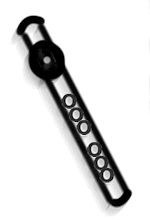The way you treat your flute directly affects how well the instrument performs for you. Having an instrument in good working condition is important to your musical progress. Here you will find a list of guidelines to help you maintain and care for your flute. These tips, in addition to having your flute serviced at least once per year by a trained flute technician, will keep your flute in good working condition so that you can spend more time playing music.
____________________________________________
- When you first open your flute case, notice how the three pieces of your instrument are arranged inside the case. Remember this position when it is time to return your flute to its case. If you put either of the keyed pieces into the case incorrectly, you risk bending the keys. Be careful where you choose to hold the instrument because holding the keyed mechanisms can bend keys or simply shift them slightly out of alignment. To save money on repair costs and frustration associated with keys that do not close correctly, handle your flute carefully.
- Handle your flute with care when you put it together. Hold the flute by the portions without keyed mechanisms, and hold the head joint anywhere but the embouchure plate or the crown. For example, you will want to hold the foot joint below all of the keys, and you will want to hold the middle piece above all of the keys and rods. Then, gently slide one joint into the other. If you must apply a great deal of pressure to get the joints to fit, you might need to clean the metal interlocking parts with a soft, clean cloth (flannel works well). Stubborn joints are usually caused by dirt buildup. Do not put cork grease on the joints because this only complicates the problem by introducing more dirt that will adhere to the cork grease.
- To disassemble your instrument, hold the pieces in the same manner you did to put the instrument together, avoiding keyed mechanisms.

- In order to get the most use out of your pads and the mechanisms on your musical instrument, you will want to use common sense when taking care of your flute.
- First, keep your flute clean. You should wipe the inside after each use using a soft cloth or handkerchief. Wrap the cloth around the cleaning rod found in your case so that none of the rod is exposed. This is especially important if your cleaning rod is metal because you do not want to scratch the inside of your flute. Gently push the cleaning rod through the entire length of the instrument, paying special attention to the head joint. I often reposition the cloth in such a way as to clean all moisture out of the head joint. After you have swabbed the head joint, look into the tube to see if there is any remaining moisture. If there is moisture, swab the joint again. For more information about cleaning your flute, see the article titled, How to Clean Your Flute.
- It is also important to maintain the appearance of the outside of your flute. I recommend gently wiping the outside area of your flute with a soft flannel cloth at least once every couple of weeks. This will keep to a minimum the amount of dust in the jointed mechanisms on the rods of the flute and will present a professional appearance when others see your flute. You may use a jeweler's cloth that contains a type of polish on the flute periodically, but never use silver polish or immerse your instrument in water.

- Besides cleaning the inside of your instrument, you should take other measures to ensure the long life of the pads on your instrument. Avoid eating sugary foods or drinking sodas before you play or practice. Sugars tend to make the pads sticky and make them rot sooner. I prefer to brush my teeth before playing my instrument, regardless of what I have had to eat or drink.
- Keeping the flute in its case when you are not using it is also a good preventative measure. While in the case, it is not exposed to changes in moisture that can ruin the pads or to dust that is constantly in the air. The case also protects it from other accidents.
- Be careful about how you lay the instrument down if you are taking a break. You should lay it where the least amount of keys are touching the surface of the table or chair. If you have a flute stand, use it. If not, take special care so that the flute does not roll over onto the keys. Never rest your flute on a music stand!
- Lastly, if your flute develops a problem, do not try to fix the problem yourself. Take it to your teacher or a repair person. If you do not know what you are doing, you could end up causing additional problems.
____________________________________________
Tips
- Wipe the inside of your flute after each use by using a soft
cloth or handkerchief. - Handle your flute with care. Avoid holding the flute by the keyed
mechanisms. - Have your flute serviced at least once per year by a trained
flute technician - Never rest your flute on a music stand!
____________________________________________
Additional Resources


No comments:
Post a Comment